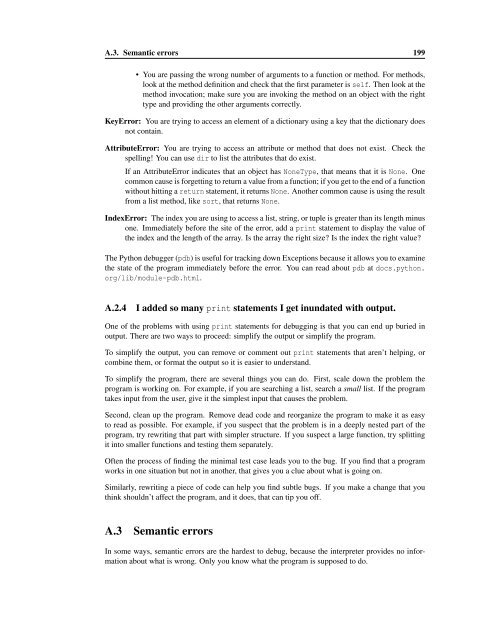You also want an ePaper? Increase the reach of your titles
YUMPU automatically turns print PDFs into web optimized ePapers that Google loves.
A.3. Semantic errors 199• You are passing the wrong number of arguments to a function or method. For methods,lookatthemethoddefinitionandcheckthatthefirstparameterisself. Thenlookatthemethod invocation; make sure you are invoking the method on an object with the righttype and providing theother arguments correctly.KeyError: You are trying to access an element of a dictionary using a key that the dictionary doesnot contain.AttributeError: You are trying to access an attribute or method that does not exist. Check thespelling! You can usedirtolistthe attributesthat doexist.If an AttributeError indicates that an object has NoneType, that means that it is None. Onecommoncauseisforgettingtoreturnavaluefromafunction;ifyougettotheendofafunctionwithouthittingareturnstatement,itreturnsNone. Anothercommoncauseisusingtheresultfrom alistmethod, likesort,that returnsNone.IndexError: Theindexyouareusingtoaccessalist,string,ortupleisgreaterthanitslengthminusone. Immediately before the site of the error, add a print statement to display the value ofthe index and thelength of the array. Isthe arraytheright size? Isthe index the rightvalue?The<strong>Python</strong>debugger(pdb)isusefulfortrackingdownExceptionsbecauseitallowsyoutoexaminethe state of the program immediately before the error. You can read about pdb at docs.python.org/lib/module-pdb.html.A.2.4 I addedsomanyprint statements Iget inundatedwith output.One of the problems with using print statements for debugging is that you can end up buried inoutput. There are twoways toproceed: simplifytheoutput or simplifytheprogram.To simplify the output, you can remove or comment out print statements that aren’t helping, orcombine them, or format the output soit iseasier tounderstand.To simplify the program, there are several things you can do. First, scale down the problem theprogram is working on. For example, if you are searching a list, search a small list. If the programtakes input from theuser, give itthe simplestinput that causes theproblem.Second, clean up the program. Remove dead code and reorganize the program to make it as easyto read as possible. For example, if you suspect that the problem is in a deeply nested part of theprogram, try rewriting that part with simpler structure. If you suspect a large function, try splittingitintosmaller functions and testingthem separately.Often the process of finding the minimal test case leads you to the bug. If you find that a programworks inone situationbut not inanother, that gives you aclue about what isgoing on.Similarly, rewriting a piece of code can help you find subtle bugs. If you make a change that youthink shouldn’t affect theprogram, and it does, that can tipyou off.A.3 Semantic errorsIn some ways, semantic errors are the hardest to debug, because the interpreter provides no informationabout what iswrong. Only you know what the program issupposed todo.
















